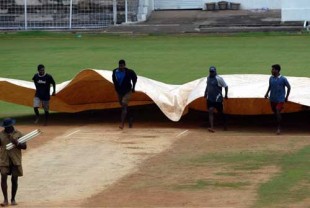Time to pitch it right
A lively pitch for the final was a pleasant sight when you consider that complete batting beauties were served up for the semi-finals
Sriram Veera in Hyderabad
12-Jan-2009

| ||
A lively pitch for the final was a pleasant sight when you consider that complete batting beauties were served up for the semi-finals. The new ball seamed around in the first session and though Mohammad Kaif kept dropping catches in the slips, there was good carry and bounce throughout the day. As the sun came out, the ball came on to the bat nicely. It was a perfect first-day deck and YL Chandrasekhar, the curator, walked around the arena proudly after the day's play and Daljit Singh, the chairman of the BCCI pitches committee, too was a happy man.
Good "sporting pitches" have dominated every player and fan's wish-list and many have wondered why India have not been able to consistently produce good tracks in domestic cricket. Daljit provided a host of reasons while also lamenting the treatment of the groundsmen.
"A groundsman's condition is pathetic. We should be ashamed how we are treating them. With all the money coming in, the situation has to improve. There are good places like Chennai
where they are treated well but in many other areas, it's a very sad situation still. People who are running the game should be ashamed. We are hoping that in a year or two things will look up as the talk is going on inside the BCCI on how to make the associations realise the importance of groundsmen and on the art of producing good wickets."
The art of preparing a good pitch is yet to be perfected in India. Six weeks back, the board sent out a guide book on preparing pitches to all associations and have asked them to get it translated into local languages. So what does the book contain? Daljit explains. "Apart from knowing how to lay a wicket, the type of soil (red or black etc), the correct mixture of morrum and clay and the correct grass (Bermuda hybrid is the best), it also comes down to how you prepare the wicket.
"The classic example is the 2006 Champions Trophy at the CCI ground [Brabourne Stadium] in Mumbai. They produced awful wickets - slow, low and powdery pitches spoiled the game so much that the final was almost shifted out of it. Andy Atkinson, the ICC grounds guy [chief pitch consultant], brought glue from England and all that. It was a farce. We later discussed with the local people how they prepared. We learnt they would mark the wicket and zero-cut the grass. That's old and outdated."
Cut the grass? Daljit gives the dummy's guide to preparing a pitch. "You should have liberal grass - now we have stipulated a 6mm standard - when you prepare a wicket. And four inches of soil under the wicket to produce good hard pitch. First you wet it properly - don't flood it and say you have wet it but wet it three-four times a day for two or three days. Then you bring the rollers - use the light rollers for the cross roll and diagonal roll and the heavy roller for straight roll.
"The top one-and-a-half inches dries from sun and air. The below two-and-half is through transpiration (evaporation of water from plants). If we have deep root and good foliage on top, then the transpiration takes place. If that doesn't happen, the wicket below doesn't get hard. If we don't keep liberal grass on top it will affect [the hardness of the pitch]. The rolling only smoothens the wicket; it doesn't harden the surface inside.
"The cricket soil should swell when it's wet. The heavy roller just shapes the wickets, not dry it. If you understand this, you can make hard wickets. The CCI have learnt that now and have started producing fantastic wickets. The ones produced for the Ranji Plate League final last year and the three games that were played there this year [in the Ranji Trophy] were all good wickets."
The other thing that Indians grounds don't have is proper drainage blocks around the pitch. "In the long run it spoils the root of the grass and so much muck gets accumulated below that wickets go from bad to worse," Daljit says. "We got to have drainage around."
The BCCI, which has been conducting pitch seminars for the groundsmen in recent times, has asked each association to name four grounds they will maintain next year for its matches. "Since too much cricket is being played in a season - trial games, camps, inter-district matches, local tournaments, Ranji Trophy, IPL - there is no time to rest the pitches," Daljit says. "With more grounds, the association can spread their games better."
As a parting shot, Daljit once again talks about the plight of the groundsmen. "They are unfortunately not trained. All the people come to this profession as means of picking up a job or just for the love of cricket. Time has come to make it a profession."
Sriram Veera is a staff writer at Cricinfo